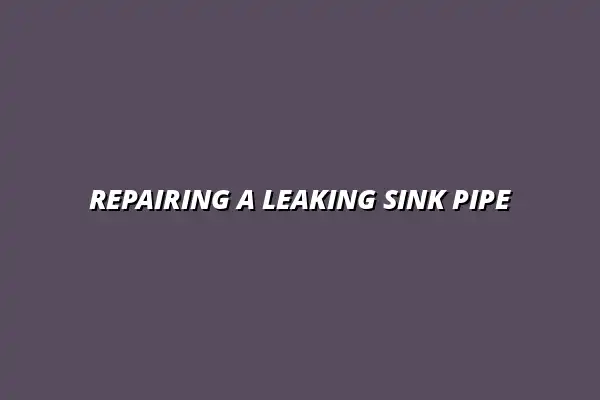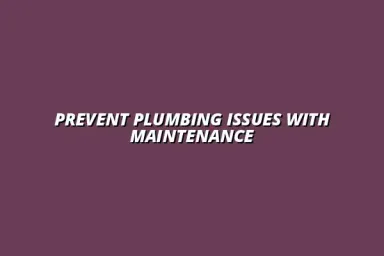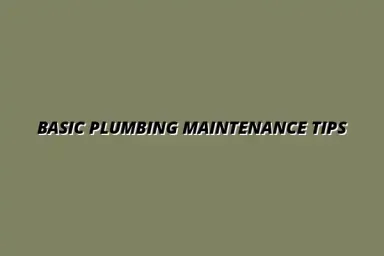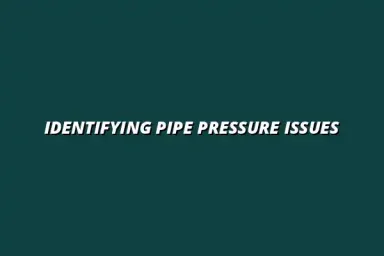Understanding the Causes of a Leaking Pipe Under the Sink
Leaking pipes under the sink can be a real headache for homeowners. Understanding the root causes can help you prevent future leaks and save money on repairs. In this section, we’ll explore some of the most common reasons why pipes start leaking, so you can be better prepared to handle any plumbing issues that may arise.
Common Reasons Behind a Leak
Leaks can happen for various reasons, and knowing them can help you identify the issue quicker. Here are some of the most common culprits:
- Wear and Tear from Age
- Faulty Joints and Connections
- Corrosion and Pipe Damage
- High Water Pressure Implications
Wear and Tear from Age
As time goes on, pipes can become less reliable due to age. Older pipes may crack or become brittle, leading to unfortunate leaks. Regular inspections can help you catch these problems early, saving you from bigger issues later on!
Faulty Joints and Connections
Another frequent source of leaks is faulty joints or connections between pipes. Poor installation or worn-out seals can create gaps where water can escape. It’s essential to ensure that joints are properly sealed and regularly checked for any signs of leakage. For example, learning how to fix a leaking bathroom pipe joint can be a valuable skill.
Corrosion and Pipe Damage
Over time, pipes can corrode due to exposure to water and air. This corrosion weakens the pipe material, making it more susceptible to leaks and breaks. If you notice rust or discoloration around your pipes, it’s a good indication that they may be damaged and need attention!
High Water Pressure Implications
Increased water pressure can also lead to leaks. When water pressure is too high, it can stress pipes and joints, causing them to fail. It’s advisable to check your system’s water pressure and ensure it’s within a safe range to avoid leaks. Understanding how to prevent pipe leaks with maintenance is crucial for long-term plumbing health.
Assessing the Situation: Identifying the Source of the Leak
Once you suspect a leak, the next step is to identify its source accurately. Knowing where the leak is coming from can save you time and effort in repairs. In this section, we’ll discuss effective techniques you can use to locate the leak swiftly.
Visual Inspection Techniques
One of the best ways to find a leak is through careful visual inspection. Here are some methods you can use:
- Checking for Visible Water Damage
- Locating the Source with Dry Cloths
Checking for Visible Water Damage
Start by looking for any signs of water damage around the sink area. Stains, discoloration, and peeling paint can indicate a leak nearby. Pay close attention to the cabinet beneath the sink, as this is often a hotspot for leaks!
Locating the Source with Dry Cloths
Another effective method is to use dry cloths. Simply wipe around the pipes and joints, checking for moisture. If the cloth comes away damp, you’ve likely found the source of the leak!
Tools and Materials Needed for Repair
Before starting any repairs, it’s essential to gather the right tools and materials. If the leak is under your kitchen sink, a helpful guide is available on fixing kitchen sink leaks. Here’s a handy list of what you’ll need:
- Essential Tools for Pipe Repair: Wrench, Pliers, Screwdriver
- Recommended Sealants and Replacement Parts: Pipe Sealant, Replacement Washers, New Pipe Sections
Essential Tools for Pipe Repair
Having the right tools makes the repair process much easier. A wrench and pliers are crucial for tightening connections, while a screwdriver can help with any screws that hold pipe fittings in place. Ensuring you have these tools ready will make you feel more confident in tackling repairs!
Recommended Sealants and Replacement Parts
When it comes to fixing leaks, sealants play a vital role. Using high-quality pipe sealant can help ensure a tight seal. If you find that a pipe is damaged, be sure to have replacement parts on hand to make the repair as seamless as possible.
Preventative Measures to Avoid Future Leaks
Preventing leaks is often easier than repairing them! By incorporating some simple practices into your routine, you can keep your plumbing system in top shape and avoid those pesky leaks. For more extensive leaks, such as those under the foundation, professional help is often necessary. Below are some effective strategies to help you stay ahead of potential issues.
Regular Maintenance Practices
One of the best ways to prevent leaks is to establish a regular maintenance routine. This can save you time and money in the long run. Here’s a quick list of practices you can adopt:
- Perform visual inspections of pipes and fittings every few months.
- Look for signs of wear, such as rust or discoloration.
- Schedule routine plumbing check-ups with a professional.
Inspections to Catch Issues Early
Regular inspections can catch small problems before they turn into big headaches. By checking your plumbing fixtures and connecting points, you might spot issues like:
- Drips and leaks around joints.
- Unusual water stains on ceilings or walls.
- Musty odors indicating hidden leaks.
Consider setting reminders to check your pipes at least twice a year!
Understanding Pipe Materials and Their Longevity
Knowing what materials your pipes are made from can greatly influence your maintenance approach. Different materials have varying lifespans and resistances to corrosion and other factors. Here’s a summary of common pipe materials:
- PVC: Durable and resistant to corrosion; ideal for drainage.
- PEX: Flexible and easy to install; great for retrofits.
- Copper: Long-lasting but can corrode over time; check regularly.
- Galvanized Steel: Strong but may rust; consider replacing old pipes.
Choosing the Right Pipes for Your Home
Selecting high-quality pipes can prevent future leaks and other plumbing issues. When considering new installations or replacements, keep in mind:
- Local climate and water quality.
- The expected lifespan of the material.
- Your budget for installation and maintenance.
Doing some research now can save you from problems down the road!
Common Questions and Expert Insights about Leaking Pipes
As a homeowner, it’s normal to have questions about plumbing and leaks. Understanding the basics can empower you to handle situations more effectively. Here’s a look at some frequently asked questions.
Frequently Asked Questions
How can I tell if my leak is serious?
Determining the severity of a leak can be tricky. Here are some warning signs that indicate you may need to take action:
- Water pooling under the sink or around the base of the pipes.
- Increased water bills without an explanation.
- Signs of mold or mildew in your home.
If you notice any of these signs, it’s best to investigate further. For serious issues or if you are uncomfortable with DIY repairs, consider contacting a local plumber, such as a plumber in Billesley, Birmingham.
What to do if the leak persists after repair?
If you’ve attempted repairs but the leak continues, don't panic! Here’s what you can do:
- Double-check your repair job to ensure everything is tight.
- Look for additional leaks in nearby pipes or connections.
- Consider seeking professional help if the issue persists.
Sometimes a fresh set of eyes can spot what you might have missed!
When to Seek Professional Help
Knowing when to call in a pro can save you time and stress. Here are some indicators that it’s time to seek expert assistance:
- Widespread leaks affecting multiple areas of your home.
- Repeated problems with the same pipe or fixture.
- Uncomfortable with handling plumbing repairs yourself.
Don’t hesitate to reach out for help when you need it! Issues with water heaters, for instance, often require specialized expertise, such as that found in a guide on repairing a leaking water heater pipe.
Indicators of Complex Plumbing Issues
Complex plumbing issues can often be beyond DIY fixes. Watch out for:
- Low water pressure across multiple fixtures.
- Unusual noises like gurgling or hissing from pipes.
- Water discoloration or foul smells.
These could be signs of deeper problems requiring a professional’s expertise!
Benefits of Hiring a Licensed Plumber
Hiring a licensed plumber comes with several advantages that can make a big difference. Here’s why it’s worth considering:
- Expertise in diagnosing complex issues.
- Access to specialized tools and technology.
- Assurance of quality work and compliance with local codes.
Ultimately, investing in a professional can lead to better long-term plumbing health. Addressing slow draining pipes, for example, is often best left to a professional, but you can find helpful information about fixing slow draining bathroom pipes online.
Final Thoughts on Maintaining Your Plumbing System
Keeping your plumbing in good condition doesn’t just help avoid leaks; it can also enhance your home’s overall health. Timely repairs and regular maintenance play a crucial role in protecting your investment.
The Importance of Timely Repairs
Cost-Effectiveness of Minor Repairs
Addressing small leaks or issues can save you a lot of money over time. Consider this:
- Small fixes often cost less than major repairs.
- Minor leaks can lead to extensive water damage if ignored.
- Early intervention can prevent the need for complete replacements.
Being proactive is key to effective home maintenance!
Encouragement for Homeowners
Empowering Homeowners to Perform Basic Repairs
Every homeowner can benefit from learning some basic plumbing skills. Here are a few reasons to empower yourself:
- Save money on repairs by doing them yourself.
- Gain confidence in handling home maintenance tasks.
- Build a sense of accomplishment by solving problems independently.
With a little knowledge, you can take care of your home!
Building a Knowledge Base for Home Maintenance
Continuously learning about home maintenance can help you stay prepared. Consider these tips:
- Read books or articles on plumbing basics.
- Watch tutorial videos to learn repair techniques.
- Join local home improvement workshops for hands-on experience.
With time and practice, you’ll feel more equipped to tackle any plumbing challenge!

 Kiran Almasi
Kiran Almasi

